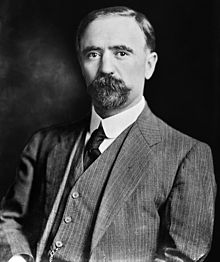Francisco Madero
| Francisco I. Madero | |
|---|---|
 |
|
|
33rd President of Mexico |
|
|
In office 6 November 1911 – 19 February 1913 |
|
| Vice President | José María Pino Suárez |
| Preceded by | Francisco León de la Barra |
| Succeeded by | Pedro Lascuráin |
| Personal details | |
| Born |
30 October 1873 Parras de la Fuente, Coahuila, Mexico |
| Died | 22 February 1913 (aged 39) Mexico City, Mexico |
| Nationality | Mexican |
| Political party | Progressive Constitutionalist Party(previously Anti-Reelectionist Party) |
| Spouse(s) | Sara Pérez, no children |
| Relations |
Brothers: Ernesto Madero Emilio Madero Gustavo A. Madero Raúl Madero Gabriel Madero |
| Parents | Francisco Ignacio Madero Hernández (father) Mercedes González Treviño (mother) |
| Residence | Coahuila |
| Alma mater | University of California, Berkeley |
| Profession | Statesman, writer, revolutionary |
| Religion | Spiritism |
Francisco Ignacio Madero González (Spanish pronunciation: [fɾanˈsisko igˈnasjo maˈðeɾo ɣonˈsales]; 30 October 1873–22 February 1913) was a Mexican statesman, writer, and revolutionary who served as the 33rd president of Mexico from 1911 until his assassination in 1913. He was an advocate for social justice and democracy. Madero was notable for having challenged Mexican President Porfirio Díaz for the presidency in 1910 and being instrumental in sparking the Mexican Revolution.
Born into an extremely wealthy landowning family in northern Mexico, Madero was an unusual politician, who until he ran for president in the 1910 elections, had never held office. In his 1908 book entitled The Presidential Succession in 1910, Madero called on voters to prevent the sixth reelection of Porfirio Díaz, which Madero considered anti-democratic. His vision would lay the foundation for a democratic, 20th-century Mexico, but without polarizing the social classes. To that effect, he bankrolled the Anti-Reelectionist Party (later the Progressive Constitutional Party) and urged Mexicans to rise up against Díaz, which ignited the Mexican Revolution in 1910.
Madero's candidacy against Díaz garnered widespread support in Mexico, since he was someone of independent financial means, ideological determination, and bravery to oppose Díaz when it was dangerous to do so. Arrested by the dictatorship shortly after being declared Presidential candidate by his party, the opposition leader escaped from prison and launched the Plan of San Luis Potosí from the United States, in this manner beginning the Mexican Revolution.
Following the resignation of Díaz from the presidency on 25 May 1911 after the signing of the Treaty of Ciudad Juárez, Madero became the highest political leader of the country. Known as "Maderistas", Madero's followers referred to him as the "caudillo de la Revolución" (leader of the Revolution). He was elected president on 15 October 1911 by almost 90% of the vote. Sworn into office on 6 November 1911, he became one of Mexico's youngest elected presidents having just turned 38. Despite considerable popularity amongst the people, Madero's administration soon encountered opposition both from more radical revolutionaries and from remnants of the former regime.
...
Wikipedia
